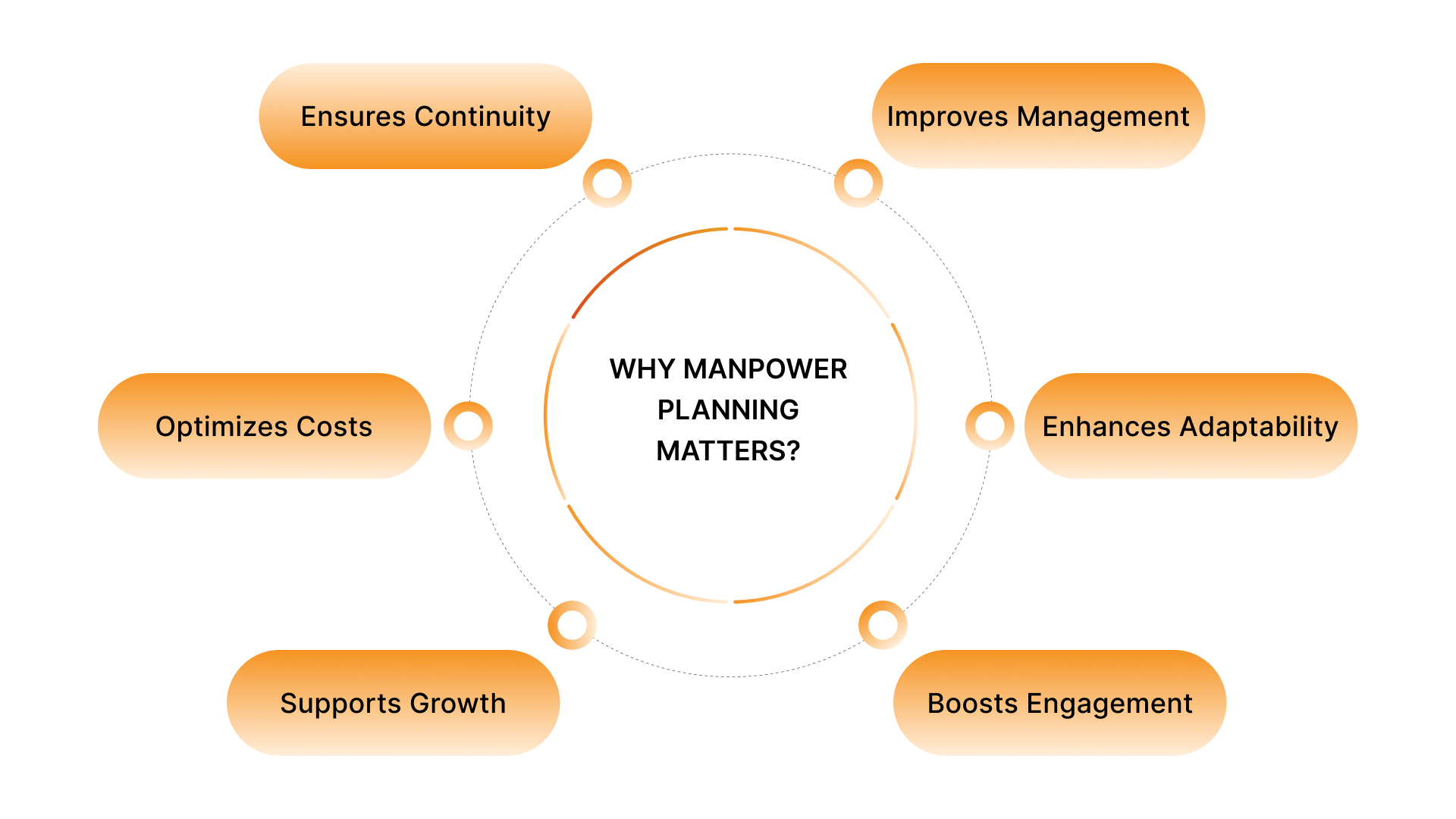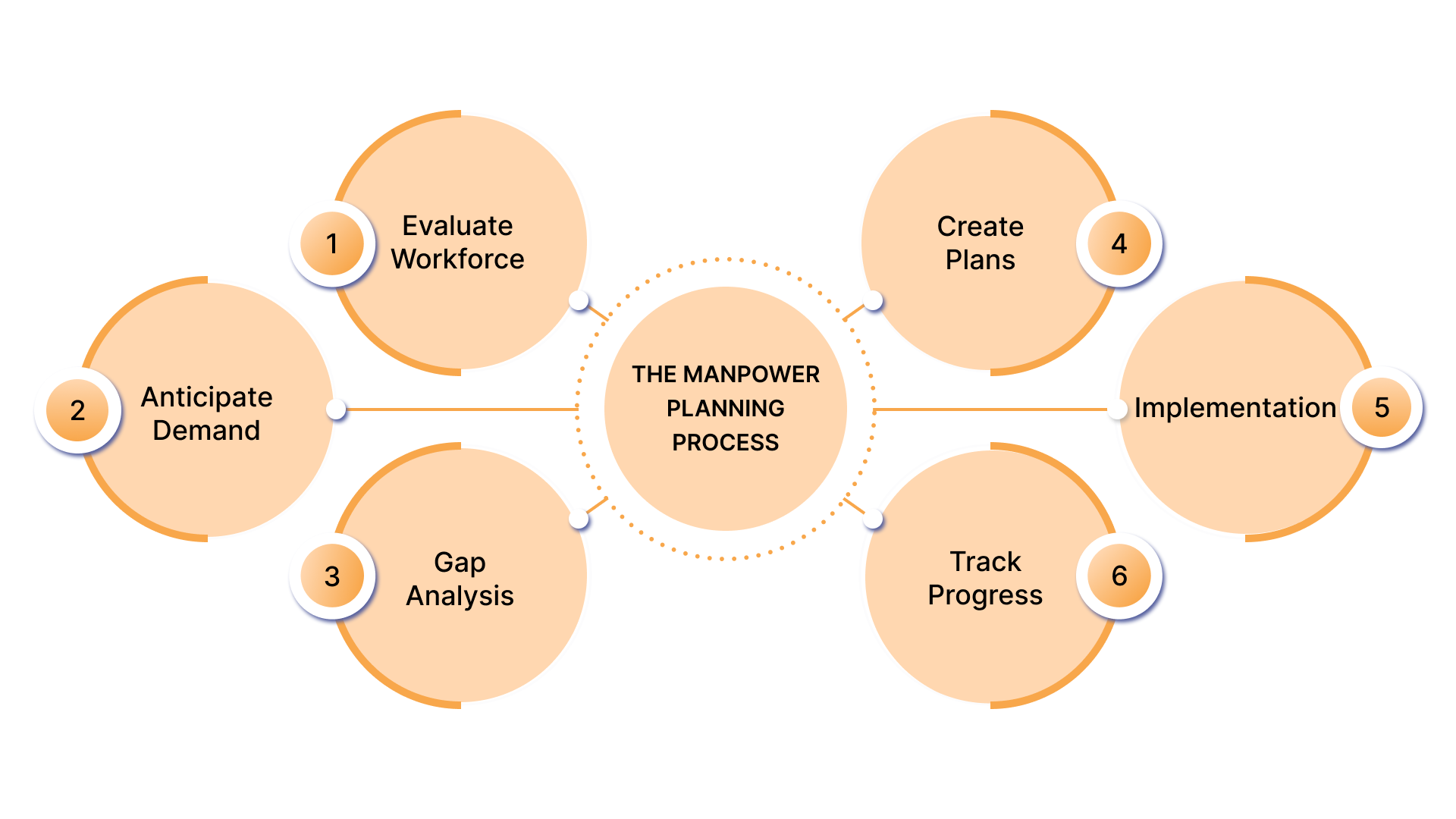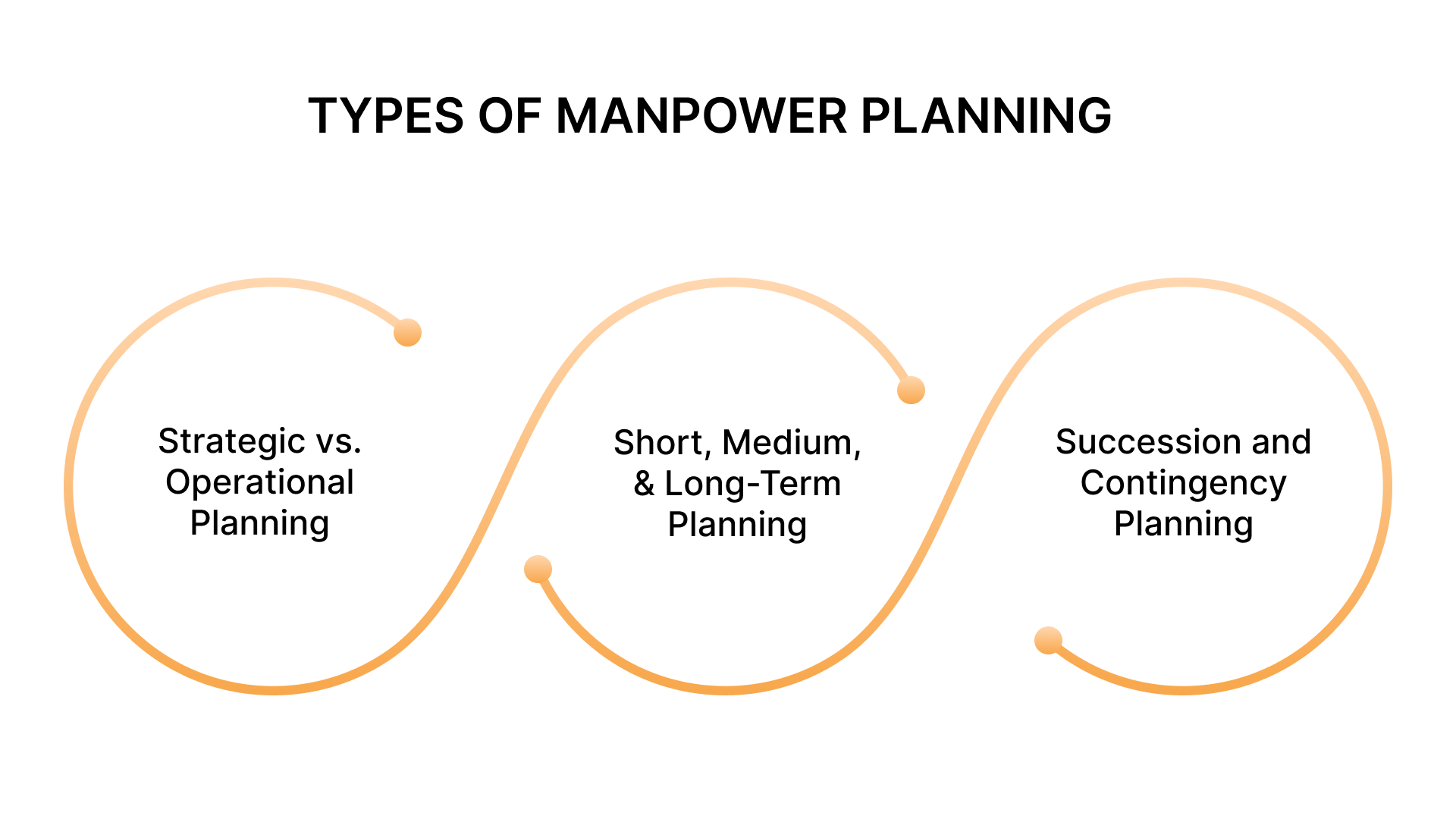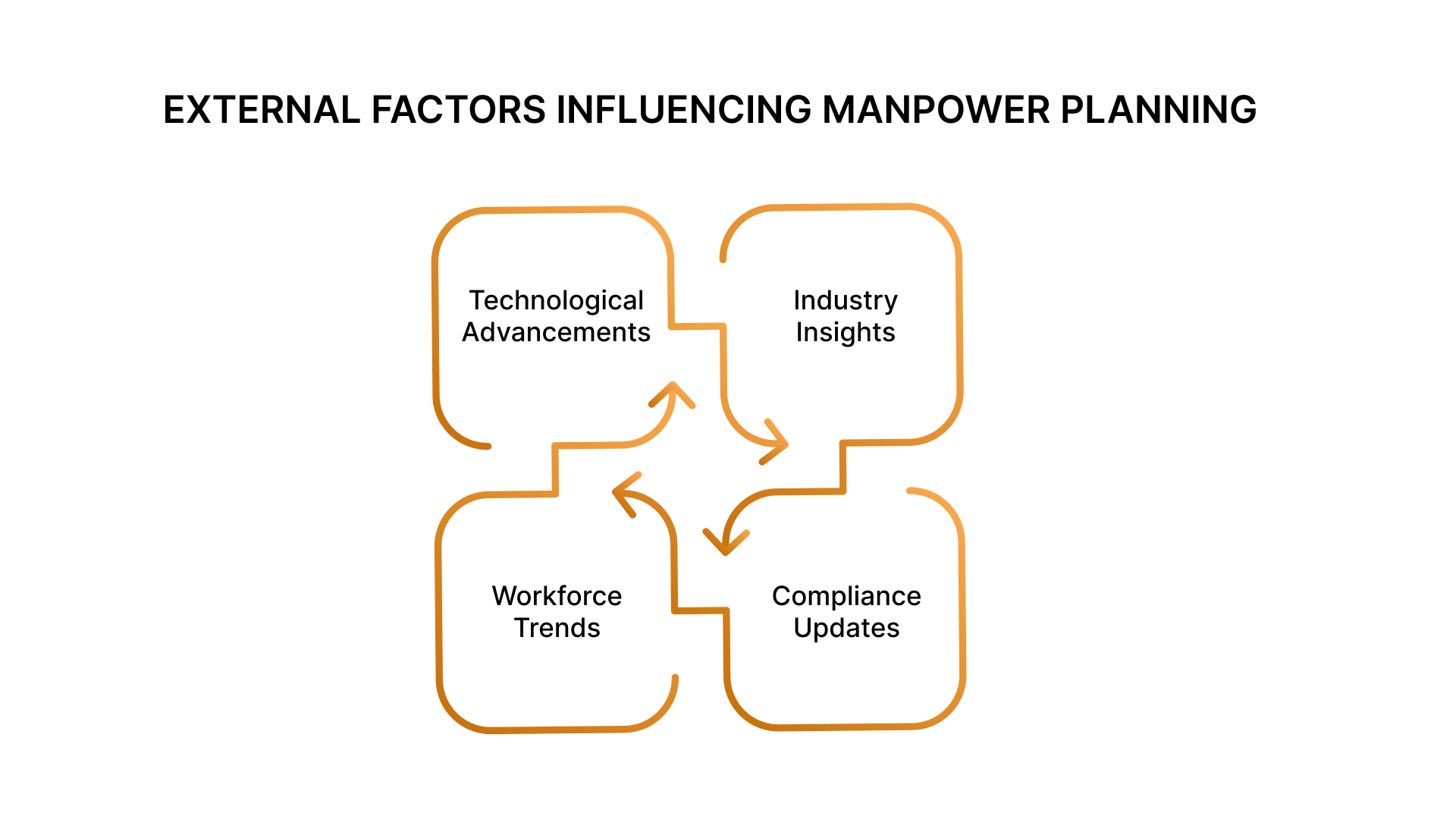As businesses strive to stay competitive and achieve their goals, the demand for skilled talent has never been greater. Yet, a significant 74% of employers globally report challenges in finding skilled talent, directly impacting their ability to meet business objectives. This shortage isn’t just a statistic; it’s a daily operational reality that can stall growth, delay projects, and strain teams.
Maybe you’ve felt that pressure too, where a key role sits open for weeks, projects slow down, and your team feels stretched thin. It’s frustrating, and it’s more common than you think.
That’s where manpower planning comes in.
Instead of scrambling when a gap appears, you can take charge. Manpower planning goes beyond recruitment; it involves strategically aligning your workforce with organisational goals.
By forecasting future needs, identifying skill gaps, and implementing targeted recruitment and development strategies, businesses can ensure they have the right talent in place at the right time.
Key Takeaways
- Analyze the current workforce and forecast future needs to align talent with business goals.
- Create targeted recruitment, training, and succession plans to fill skill gaps.
- Continuously adapt manpower plans based on market, technology, and organizational changes.
- Implement strategies, communicate clearly, and regularly review for ongoing improvement.
What Is Manpower Planning in HRM?
Manpower planning, also known as human resource planning, is the systematic process of forecasting an organisation’s future staffing needs and ensuring the right number of employees with the right skills are available at the right time. It involves:
- Analysing the current workforce: Assessing the skills, roles, and numbers of existing employees.
- Forecasting future requirements: Predicting how many employees and what skills will be needed to meet organisational goals.
- Identifying gaps: Comparing current resources with future needs to spot shortages or surpluses.
- Developing strategies: Creating action plans to recruit, train, or redeploy staff as needed.
This process is ongoing and adapts to changes in business direction, technology, and market trends. The goal is to have the right people, in the right roles, at the right time, maximising organisational effectiveness and agility.
Knowing the process is only part of the equation. The real question is: how does manpower planning drive measurable outcomes and support business continuity, growth, and agility?
Benefits Of Manpower Planning

When 71% of CEOs say their employees are the most important factor in their company’s economic success, it’s clear that effective manpower planning is not just an HR function; it’s a tactical business imperative.
A strategic approach to manpower planning delivers several critical advantages including:
- Ensures business continuity: Prevents skill shortages that can disrupt operations or delay projects.
- Optimizes workforce costs: Avoids overstaffing and reduces unnecessary labour expenses.
- Supports growth and change: Aligns talent with business expansion, restructuring, or new initiatives.
- Improves talent management: Identifies skill gaps early and enables targeted recruitment, training, and succession planning.
- Enhances adaptability: Prepares the organisation to respond quickly to market or technological changes.
- Boosts employee engagement: Facilitates career development and internal mobility, increasing retention.
If your HR team is stretched thin, Recruitment Process Outsourcing (RPO) from V3 Staffing can take over all or part of your hiring process, freeing your team to focus on core business priorities.
Looking for a reliable partner to meet your hiring needs? V3 Staffing is here to provide the right talent and solutions to drive your business forward.
The next step is to look at how organisations can translate intent into outcomes through a structured manpower planning process.
The Manpower Planning Process

To successfully implement manpower planning, there is a sequence of well-defined steps that help organisations predict future needs, bridge skill gaps, and align their workforce with business objectives.
Here’s a comprehensive breakdown of the process, including actionable tips to make each step more effective.
1. Assess Current Workforce / Analyse Labour Supply
Key Actions:
- Review employee data: Start by analysing your current workforce. Look at key data such as number of employees, skills, experience, job roles, performance metrics, and potential for growth.
- Understand talent pool: Assess internal talent to identify both strengths (such as high performers) and gaps (such as underutilised employees or skills shortages).
Actionable Tips:
- Use HR software to generate reports that give you a snapshot of current employees’ performance and skill sets.
- Regularly update employee profiles to track changes in qualifications or shifts in roles.
- Conduct regular skills assessments to understand where employees excel and where they need further development.
2. Forecast Future Needs / Demand Forecasting
Key Actions:
- Predict future requirements: Analyse factors like business growth projections, upcoming projects, market trends, technological changes, and organisational expansion to determine the type and number of employees needed in the future.
- Factor in business strategy: Align manpower forecasts with business objectives, such as new product launches, entering new markets, or expanding current operations.
Actionable Tips:
- Collaborate with leadership and department heads to gain insight into upcoming changes in business strategies or projects that will affect staffing needs.
- Use predictive analytics and workforce planning tools to better forecast staffing requirements based on historical trends and business growth patterns.
3. Gap Analysis
Key Actions:
- Compare current workforce vs. future needs: Identify discrepancies between your existing workforce and the future demands. Focus on areas where there is a shortage of talent, underutilisation of resources, or skill mismatches.
- Assess skill gaps: Identify which critical skills are missing and whether your current workforce can be upskilled or whether you need to hire externally.
Actionable Tips:
- Perform a skills gap analysis by comparing the skills your workforce has today with those required in the future.
- Survey managers to identify areas where they foresee difficulties in meeting future business needs due to staffing shortages or skill gaps.
- Use workforce analytics tools to detect areas of underemployment or skill redundancyIdentifying leadership gaps and filling them with the right executives is just as important as addressing skill shortages in other areas. Executive Search services from V3 Staffing ensure that top-level candidates are sourced to drive your business forward..
4. Develop Strategies and Action Plans
Key Actions:
- Formulate recruitment strategies: Based on your gap analysis, decide on the actions needed to fill any gaps. This could include recruitment, training, internal mobility, or restructuring roles.
- Upskill and reskill current employees: Invest in training programmes to help employees acquire the necessary skills for future roles or to address emerging demands.
- Succession planning: Plan for leadership continuity by identifying and grooming internal candidates for key positions.
Actionable Tips:
- If hiring externally, consider talent pipelining by developing relationships with universities, industry groups, or recruitment agencies ahead of time.
- Promote internal mobility by creating pathways for employees to move across departments and take on new roles that align with their growth potential.
- Integrate learning and development programmes that focus on both technical skills (e.g., digital tools) and soft skills (e.g., leadership, communication).
5. Implementation
Key Actions:
- Execute your manpower plan: Put the strategies into action. Whether it’s recruiting new talent, retraining current employees, or restructuring teams, ensure all relevant departments are on board and resources are allocated accordingly.
- Communicate with stakeholders: Involve key stakeholders such as HR, finance, and department heads to ensure a smooth rollout of the plan.
Actionable Tips:
- Create a detailed project plan outlining specific actions, timelines, and responsibilities for each phase of the manpower planning process.
- Conduct regular check-ins with department heads to monitor progress, resolve challenges, and ensure that the plan is on track.
- Utilize a project management tool to keep track of recruitment, training, or redeployment activities, and adjust timelines as necessary.
6. Monitor, Evaluate, and Adjust
Key Actions:
- Track performance and KPIs: Regularly measure the outcomes of your manpower planning strategies, using recruitment metrics like employee turnover rates, performance reviews, training effectiveness, and overall productivity.
- Review and refine: Continuous feedback and analysis allow you to adjust the plan based on how well it’s meeting business goals and whether external factors (such as economic shifts) require modifications.
Also Read: 5 Ways HR Can Help Prevent Insider Threats
While the process outlines how to plan your workforce, understanding the types of manpower planning helps you choose the right approach based on your business horizon and talent priorities.
Best Practices for Successful Manpower Planning
To ensure your manpower planning is effective and aligns with business goals, consider these best practices:
-
Regularly Assess Workforce Skills and Needs
Continuously monitor the current skill set of your workforce and evaluate if it aligns with the future direction of the business. Regular skills audits will help you spot gaps early and address them before they become critical.
-
Collaborate with Leadership Teams
Involve key leaders across departments when forecasting workforce needs. This collaborative approach ensures that manpower planning aligns with strategic goals and that all areas of the business are covered.
-
Use Data and Predictive Analytics
Use workforce analytics to make data-driven decisions. Predictive tools can help anticipate future workforce trends and provide insights for more accurate forecasting.
-
Focus on Employee Development and Retention
Rather than always hiring externally, invest in upskilling and reskilling existing employees. Employee development is key to long-term workforce sustainability and reduces turnover.
-
Plan for Flexibility
The business environment is always changing. Build a flexible workforce that can easily scale up or down based on demand, market conditions, or new business ventures.
-
Adopt Technology for Streamlined Processes
Utilize HR software and workforce management tools to streamline recruitment, training, and workforce tracking. Automation and technology can help improve the efficiency and accuracy of your planning efforts.
-
Establish Clear Succession Plans
Having a clear succession strategy for key roles ensures business continuity during transitions. Regularly update succession plans to reflect changes in leadership or strategic priorities.
What Are The Types of Manpower Planning?

Manpower planning comes in various forms, each tailored to address specific needs within an organisation. These types of planning are based on time horizons, strategic importance, and the nature of workforce requirements. Here are three broad categories of manpower planning:
- Strategic vs. Operational Planning
- Short-Term, Medium-Term, and Long-Term Planning
- Succession and Contingency Planning.
1. Strategic vs. Operational Planning
| Type | Strategic Planning | Operational Planning |
| Focus | Long-term business alignment | Short-term staffing needs |
| Time Horizon | 3-5+ years | 1 year or less |
| Purpose | Align workforce with future business goals | Address immediate vacancies or surpluses |
| Example | Planning for global expansion | Filling temporary seasonal roles |
For projects with fluctuating workloads or short-term peaks, contract staffing through V3 Staffing allows you to scale your team quickly, without the overhead of permanent hires.
2. Short-term, Medium-term & Long-term Planning
| Type | Short-Term Planning | Medium-Term Planning | Long-Term Planning |
| Focus | Immediate, urgent staffing needs | Growth and project-specific workforce needs | Alignment with long-term business strategy |
| Time Horizon | Less than 1 year | 1 to 3 years | 3-5+ years |
| Purpose | Fill gaps and manage short-term demands | Prepare for upcoming growth and projects | Plan for future workforce needs and goals |
| Example | Temporary hires, seasonal workers | Expanding workforce for new initiatives | Preparing for technological advancements |
3. Succession and Contingency Planning
| Type | Succession Planning | Contingency Planning |
| Focus | Leadership continuity | Handling unexpected staffing disruptions |
| Time Horizon | 3-5+ years | Short-term to medium-term |
| Purpose | Develop internal leaders for key roles | Prepare for emergencies and unexpected vacancies |
| Example | Grooming senior managers for executive roles | Backup plans for sudden employee exits |
Choosing the right type of planning is only effective when it’s grounded in real-world conditions. That’s why it’s important to examine the internal and external factors that shape how manpower plans are built and adjusted.
Key Factors Influencing Manpower Planning
Understanding key internal and external factors is essential for effective manpower planning. These factors influence forecasting accuracy, strategy development, and workforce alignment, helping organisations create adaptable and realistic plans that support business goals.
Internal Factors

- Business Growth and Organisational Structure
- Impact: Business growth directly influences workforce requirements. Expanding operations, entering new markets, or launching new products require additional talent or skill sets. Changes in organisational structure may lead to adjustments in workforce size or composition.
- Assessment: Review your organisation’s growth plans, expansion strategies, and internal restructuring. Conduct regular internal assessments to understand how these changes impact workforce demand.
- Company Culture and Employee Engagement
- Impact: A company’s culture affects employee retention and productivity, which in turn impacts workforce planning. High employee satisfaction can reduce turnover, while poor engagement can lead to high attrition.
- Assessment: Use employee surveys, feedback sessions, and performance reviews to gauge morale and satisfaction. Analyse turnover rates and identify any patterns related to employee dissatisfaction.
- Existing Workforce Skills and Competencies
- Impact: The current skill set of your workforce determines whether you need to hire new employees, retrain existing staff, or hire temporary workers. Identifying skill gaps is crucial to addressing current and future needs.
- Assessment: Perform a skills audit to assess the capabilities of your current workforce. Use performance data and skills assessments to identify gaps in technical skills, soft skills, or leadership capabilities.
External Factors

- Technological Advancements
- Impact: The rapid pace of technological change affects staffing needs. New technologies might require new skill sets or lead to automation that reduces the need for certain roles.
- Assessment: Stay updated on emerging technologies relevant to your industry. Evaluate how new tech (such as AI, automation, or cloud computing) will impact your workforce needs and whether training or hiring for new skill sets is necessary.
- Market Trends and Economic Conditions
- Impact: Economic growth, market demand, and global trends shape manpower planning. Economic conditions can impact hiring decisions, salary structures, and whether the focus should be on hiring or downsizing.
- Assessment: Regularly analyse industry reports, market conditions, and economic forecasts. Assess how changes in the economy (e.g., inflation, recession) may affect demand for products/services and, consequently, the workforce.
- Labour Market Conditions
- Impact: The availability of skilled workers in the market, wage trends, and regional employment rates all influence manpower planning. A tight labour market can make recruitment more challenging and may lead to higher recruitment costs or competition for top talent.
- Assessment: Track local and global labour market trends, unemployment rates, and wage benchmarks. Collaborate with recruitment agencies and industry groups to stay informed about talent availability and shifts in demand.
- Legal and Regulatory Changes
- Impact: Changes in labour laws, employee rights, or health and safety regulations can affect manpower planning by imposing new requirements for staffing levels, working conditions, or employee benefits.
- Assessment: Monitor changes in labour laws, industry regulations, and government policies. Work closely with legal teams and HR to ensure compliance and adapt staffing strategies as needed.
Even with the right approach and awareness of influencing factors, organisations often face obstacles during execution. Understanding these common challenges and how to address them can make the difference between a plan that works on paper and one that delivers real results.
Common Challenges In Manpower Planning and How to Overcome Them
Below is a table highlighting common challenges in manpower planning, the reasons they arise, and practical solutions to address them:
| Challenge | Description | Practical Solutions & Tips |
| Forecasting Errors | Inaccurate predictions about future workforce needs due to unpredictable factors like market shifts or economic changes. |
|
| Managing Change and Resistance | Resistance from employees or management when implementing new workforce strategies or restructuring. |
|
| Technology Adoption | Challenges in adopting and integrating new HR technologies, such as workforce management or planning tools. |
|
Also Read: Integrating ChatGPT into Recruitment Strategies
How V3 Staffing Supports Effective Manpower Planning
V3 Staffing goes beyond recruitment to provide comprehensive workforce solutions tailored to businesses in Hyderabad, Bengaluru, Chennai, Pune, Delhi NCR, and Mumbai. We support mid to large enterprises with strategic talent acquisition that aligns with their growth, operational needs, and market demands.
We offer Permanent Recruitment, IT Staffing, RPO, Executive Search, and Contract Staffing, ensuring your talent strategy matches your business goals.
Key Benefits of Partnering with V3 Staffing:
- Tailored Staffing Solutions: Customized recruitment strategies based on specific project requirements, skill sets, and organizational needs.
- Industry-Specific Expertise: Access to domain experts in technology, manufacturing, BFSI, and more, ensuring the right fit for every role.
- SLA-Driven Service: Clear timelines, quality metrics, and accountability to deliver results on time and to specification.
- End-to-End Hiring Support: V3 manages the entire hiring process, from role definition to onboarding, to save you time and reduce administrative overhead.
- Risk Mitigation: Comprehensive screening, cultural alignment, and post-offer support to minimize attrition and mismatches.
If you’re looking for a trusted partner to meet your hiring needs, V3 Staffing is here to deliver the right talent. Our tailored solutions ensure seamless recruitment and staffing processes to support your growth.
Conclusion
Manpower planning gives you the clarity and control to move beyond guesswork, so your team is prepared for whatever comes next. As you put these strategies into action, remember that the right partners can make all the difference.
If you’re ready to improve your hiring outcomes in cities like Hyderabad, Bengaluru, Chennai, Pune, Delhi NCR, or Mumbai, V3 Staffing is here to help. We offer tailored solutions to build and manage teams that truly fit your goals, whether it’s through Permanent Recruitment, IT Staffing, or RPO.
Contact V3 Staffing today to build teams that match both skill and culture requirements
FAQs
Q. How does manpower planning differ from workforce planning?
A. While often used interchangeably, manpower planning typically focuses on ensuring the right number of employees are available for specific roles, often with a quantitative approach. Workforce planning is broader, encompassing both the quantity and quality of talent, future skill requirements, succession planning, and alignment with long-term business strategy.
Q. What role does data analytics play in modern manpower planning?
A. Data analytics enables organisations to make evidence-based decisions by analysing workforce trends, predicting future needs, identifying skill gaps, and measuring the effectiveness of HR initiatives. Advanced analytics and AI can improve forecasting accuracy and help organisations respond more quickly to market changes.
Q. How can organisations align manpower planning with business strategy?
A. To align manpower planning with business strategy, organisations should start by revisiting their strategic roadmap, involve leadership in setting clear objectives, and ensure workforce plans directly support business goals. Regular reviews and adjustments are essential to maintain alignment as business needs evolve.
Q. How can manpower planning help in managing workforce diversity?
A. Manpower planning supports workforce diversity by ensuring inclusive recruitment and development strategies. By aligning future staffing needs with diversity goals, businesses can build teams with varied perspectives and skills, addressing gaps in representation and fostering a more balanced workforce.
Q. How do external factors like market trends and economic conditions affect manpower planning?
A. Market trends and economic conditions directly influence manpower planning by affecting demand for products and services. A recession may reduce staffing needs, while a market boom could increase hiring. Effective manpower planning accounts for these shifts, helping businesses adjust staffing levels as needed.


